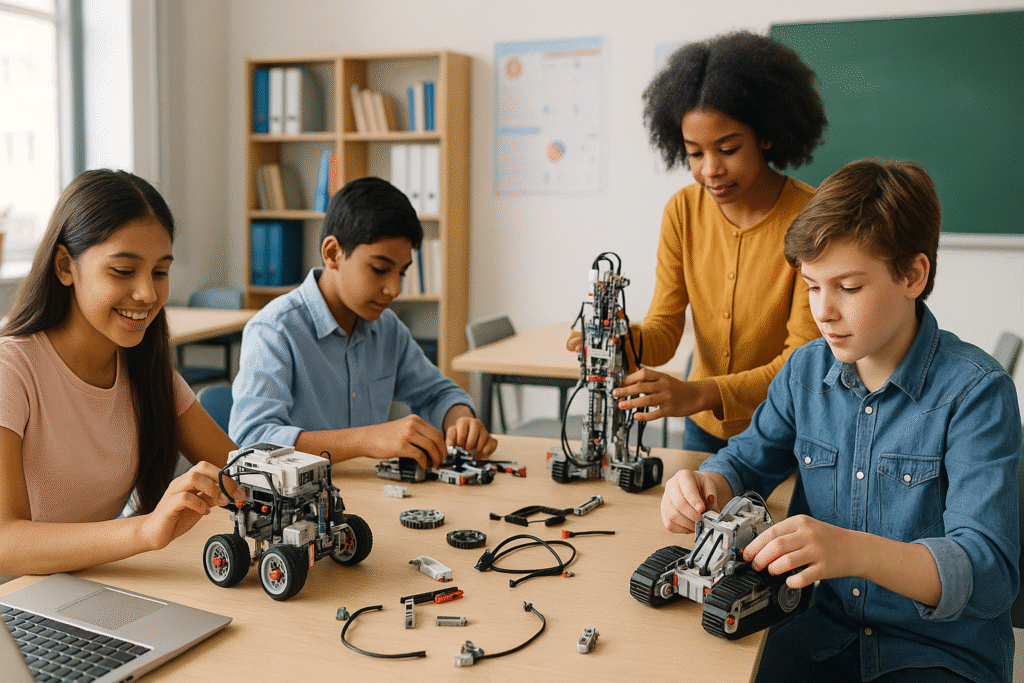How to Set Up a Robotics Lab in a CBSE School: A Step-by-Step Guide for Educators

Introduction
In today’s tech-driven world, Robotics education is no longer optional — it’s essential. CBSE’s emphasis on coding, AI, and experiential learning has made Robotics Labs a powerful tool to engage students in STEM. But how do you actually set one up in a school?
Here’s a step-by-step guide for school administrators, educators, and tech coordinators to establish a Robotics Lab in a CBSE school.
Why Robotics in Schools?
- Promotes problem-solving, logic, and creativity
- Develops coding and AI skills
- Aligns with NEP 2020 and CBSE’s skill-based learning objectives
- Encourages teamwork, design thinking, and hands-on learning
Step-by-Step Guide to Setting up a Robotics Lab
Step 1: Identify Objectives & Grade Levels
Decide whether the lab will cater to:
- Middle School (Classes 6–8)
- Secondary (Classes 9–10)
- Senior Secondary (Classes 11–12)
💡 Pro Tip: Start small (Grades 6–8) and scale based on student interest.
Step 2: Allocate Space for the Lab
- Minimum area: 400–600 sq ft
- Must have proper lighting, ventilation, and power sockets
- Tables with modular layouts for team-based work
- Storage cabinets for kits and tools
Step 3: Choose the Right Robotics Kits
Choose kits based on age and skill level. Some CBSE-aligned suggestions:
- Lego Education Kits – For beginners
- Arduino UNO/Raspberry Pi – For coding + electronics
- DIY STEM kits – Budget-friendly and engaging
- AI & IoT Kits – For advanced grades (CBSE AI curriculum)
Step 4: Install Required Software & Devices
- Laptops/Desktops (1 per 2 students)
- Internet connection
- Software: Arduino IDE, Scratch, Tinkercad, Python, or Visual Studio Code
- Online platforms for virtual coding (e.g., Code.org, RoboGarden)
Step 5: Recruit or Train Faculty
- Train 1–2 teachers under CBSE/AICTE-approved training programs
- Partner with ed-tech firms or robotics clubs
- Encourage student mentors (peer learning)
Step 6: Design Curriculum & Activities
Align projects with CBSE skills like:
- Block-based programming (Scratch)
- Sensor integration
- Line-following robots
- IoT-based weather station
- AI-based object detection
🔧 Include monthly projects, internal exhibitions, and inter-school challenges.
Step 7: Safety & Maintenance
- Install safety signs and instructions
- Assign a lab in-charge
- Schedule monthly maintenance of kits and devices
Step 8: Budget Planning
Estimated costs (for 30–40 students):
| Item | Estimated Cost |
|---|---|
| Robotics kits (10–15 units) | ₹1.5–3 Lakhs |
| Computers & software | ₹1–2 Lakhs |
| Furniture & Electrical | ₹50,000–₹1 Lakh |
| Faculty Training | ₹20,000–₹50,000 |
| Total | ₹3–6 Lakhs |
💰 Seek CSR funding, Atal Innovation Mission support, or local education grants.
Step 9: Engage Parents & Community
- Host a “Robotics Day” or STEM exhibition
- Invite parents to see student projects
- Collaborate with local tech professionals or colleges
Step 10: Register for Competitions & CBSE Events
- Inspire students to join:
- CBSE Science Exhibition
- ATL Marathon
- World Robot Olympiad (WRO)
- RoboCup Junior
Conclusion
A well-designed Robotics Lab can transform your CBSE school into a 21st-century learning hub. With the right planning, tools, and vision, your students will not just learn technology — they’ll create it.

